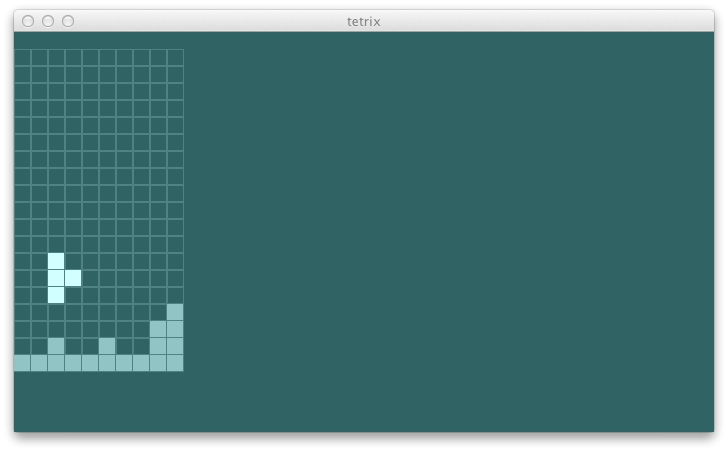Scala で書く tetrix — 時計
時計
moveLeft と moveRight があるが、moveDown が無い。これは下向きの動きが他にもすることがあるからだ。床か別のブロックに当たり判定が出た場合は、現在のピースが固まって、新しいピースが送り込まれる。
まずは、動きから:
s2"""
Ticking the current piece should
change the blocks in the view, $tick1
"""
...
def tick1 =
tick(s1).blocks map {_.pos} must contain(exactly(
(0, 0), (4, 16), (5, 16), (6, 16), (5, 17)
)).inOrder
取り敢えずテストが通過するように moveBy を使って tick を実装する:
val tick = transit { _.moveBy(0.0, -1.0) }
次に、新しいピースの転送:
s2"""
or spawn a new piece when it hits something. $tick2
"""
...
def tick2 =
Function.chain(Nil padTo (18, tick))(s1).
blocks map {_.pos} must contain(exactly(
(0, 0), (4, 0), (5, 0), (6, 0), (5, 1),
(4, 17), (5, 17), (6, 17), (5, 18)
)).inOrder
transit メソッドは既に変更された状態の妥当性を知ってる。現在は getOrElse を使って古い状態を返しているだけだけど、そこで別のアクションを実行すればいい。
private[this] def transit(trans: Piece => Piece,
onFail: GameState => GameState = identity): GameState => GameState =
(s: GameState) => validate(s.copy(
blocks = unload(s.currentPiece, s.blocks),
currentPiece = trans(s.currentPiece))) map { case x =>
x.copy(blocks = load(x.currentPiece, x.blocks))
} getOrElse {onFail(s)}
onFail が渡されなければ identity 関数が用いられる。以下が tick だ:
val tick = transit(_.moveBy(0.0, -1.0), spawn)
private[this] def spawn(s: GameState): GameState = {
def dropOffPos = (s.gridSize._1 / 2.0, s.gridSize._2 - 3.0)
val p = Piece(dropOffPos, TKind)
s.copy(blocks = s.blocks ++ p.current,
currentPiece = p)
}
テストを通過したか確認する:
[info] Ticking the current piece should
[info] + change the blocks in the view,
[info] + or spawn a new piece when it hits something
タイマー
抽象UI の中で tick を下矢印キーとタイマーに配線しよう:
import java.{util => ju}
private[this] val timer = new ju.Timer
timer.scheduleAtFixedRate(new ju.TimerTask {
def run { state = tick(state) }
}, 0, 1000)
...
def down() {
state = tick(state)
}
これで現在のピースが勝手に動くようになったけど、swing UI はそのことを知らないので描画はされない。mainPanel を 10 fps で再描画するタイマーを加えてこの問題を直す:
val timer = new SwingTimer(100, new AbstractAction() {
def actionPerformed(e: java.awt.event.ActionEvent) { repaint }
})
timer.start

一番下の列
明らかな問題は一番下の列が消えていないことだ。以下のスペックでテストできると思う:
"""It should also clear out full rows.""" ! tick3^
...
val s3 = newState(Seq(
(0, 0), (1, 0), (2, 0), (3, 0), (7, 0), (8, 0), (9, 0))
map { Block(_, TKind) })
def tick3 =
Function.chain(Nil padTo (18, tick))(s3).
blocks map {_.pos} must contain(
(5, 0), (4, 17), (5, 17), (6, 17), (5, 18)
).only.inOrder
続きはまた明日。
$ git fetch origin
$ git co day2v2 -b try/day2
$ sbt swing/run
Next Page
❧
3日目